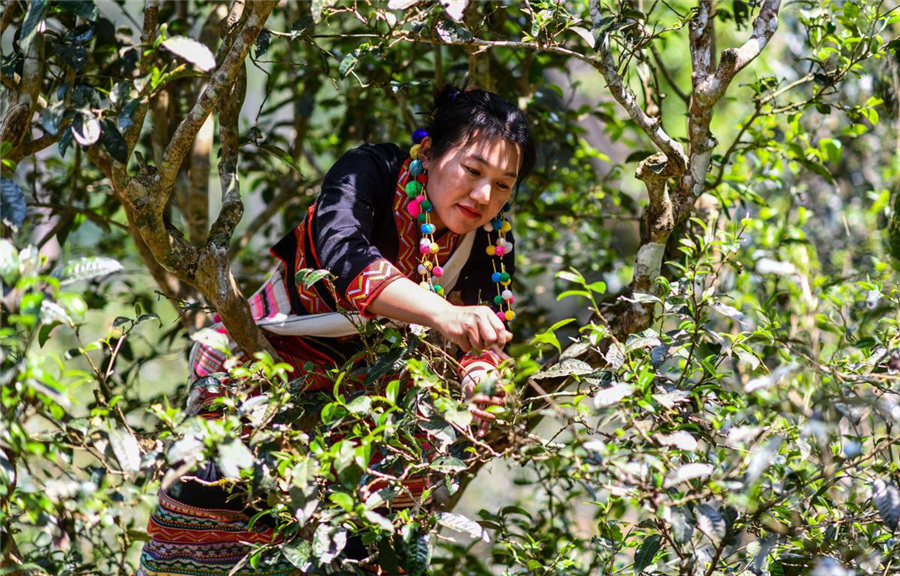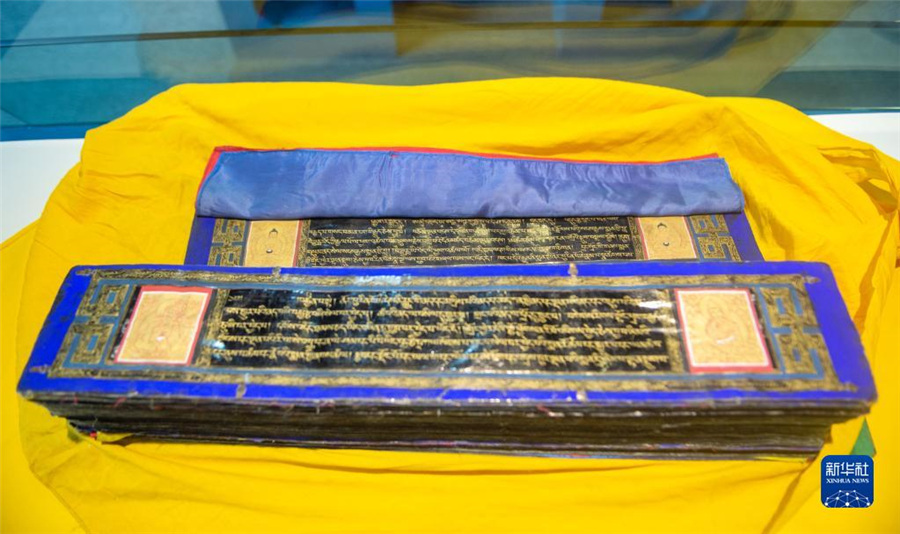Year-ender: Top 10 cultural events from 2023
From:Chinadaily.com.cnAuthor: 2024-01-04 16:05
The year 2023 witnessed the occurrence of significant cultural events, with culture and tourism becoming even more closely intertwined. Let's review the major cultural events of 2023 as we bid farewell to the year and embrace the new year of 2024!
1. Protection plan released for Beijing's Central Axis
The protection management plan for Beijing's Central Axis from 2022 to 2035 was released in January of 2023, marking a new stage in its conservation, sustainable development and application as a UNESCO World Heritage Site.
The plan is said to be one of the necessary steps toward bidding for UNESCO World Heritage status, and its release and implementation will play an important role in the protection and management of the capital's central axis.
Alongside regulations on the protection of the Central Axis carried out earlier, the plan is in line with the requirements of World Heritage conservation and provides a directional strategy and basis for conservation management.
The 21 member countries of the World Heritage Committee will decide on whether Beijing's Central Axis can be added to the World Heritage List at the committee's 46th annual conference in 2024. If the application succeeds, it will reinforce Beijing's top position among cities worldwide by number of World Heritage Sites.
2. Traditional Chinese cultural elements shine at Hangzhou Asian Games
Highlighting the humanistic aspect of Hangzhou Asian Games, Chinese cultural elements were showcased in many aspects.
As the Mid-Autumn Festival this year coincided with the 19th Asian Games, mooncakes, jade rabbits and the osmanthus scent could be seen and smelled in every corner of the Asian Games Village, and a series of galas and interactive activities were held, allowing participants to fully experience the festive culture.
In addition, the Culture Center in the media village of the Games not only showcased traditional Chinese culture, such as seal carving, fan-making and woodworking, but also offered interactive experiences like 3D interactive Baduanjin Qigong exercises, herbal plant tie-dyeing and making of sachets stuffed with Chinese herbal medicine.
What's more, the torch of the 19th Asian Games – named the "Eternal Flame", featured patterns and motifs from ancient Chinese culture. Among these design elements, the elaborate swirls on the body of the torch were based on the evolution of the Liangzhu culture, which are shaped like dermatoglyphic fingerprint patterns.
Besides, a notable innovation for this Asian Games is the floral vessel. Drawing inspiration from Huagu, a broad-lipped, long-stemmed vessel from the Southern Song (AD 1127-1279) Imperial Kiln, Dongyang Wood Carving, which is recognized as a National Intangible Cultural Heritage, crafted this vessel.

A farmer picks tea leaves on Jingmai Mountain on March 25 at the start of the spring tea harvest. [Photo/Xinhua]
3. Old tea forests in Pu'er win World Heritage Site title
The Cultural Landscape of Old Tea Forests of the Jingmai Mountain in Pu'er gained World Heritage Site status at the 45th session of the World Heritage Committee of UNESCO in Riyadh, Saudi Arabia on Sept 17, becoming China's 57th entry to the list and the first World Heritage Site related to tea.
The newly named heritage site, located in Lancang Lahu autonomous county in Pu'er, Yunnan Province, comprises five large-scale, well-preserved old tea forests, which stand 1,250 to 1,500 meters above the sea level; three protective barrier forests; and nine ancient villages in the old tea forests, which are mainly inhabited by Blang and Dai ethnic groups.
The cultural landscape was jointly created by the ancestors of the Blang people — who immigrated to the Jingmai Mountain in the 10th century AD and later discovered and domesticated wild tea trees — and the indigenous Dai people.
4. Four Chinese villages named Best Tourism Villages by UNWTO
Four rural villages in China were named Best Tourism Villages 2023 on Oct 19, an accolade given by the World Tourism Organization (UNWTO) which recognizes villages that are leading the way in nurturing rural areas and preserving landscapes, cultural diversity, local values and culinary traditions.
The four villages are: Xiajiang village from Zhejiang Province, Huangling village from Jiangxi Province, Zhagana village from Gansu Province and Zhujiawan village from Shaanxi Province.
The announcement was made at the UNWTO's 25th General Assembly in Samarkand, Uzbekistan. Launched in 2021, the Best Tourism Villages by UNWTO initiative is part of the UNWTO Tourism for Rural Development Programme. So far, a total of eight villages from China were named in the list, having China rank first globally.

The manuscripts of Four Treatisescollected at the Tibetan Hospital in Tibet Autonomous Region. [Photo/Xinhua]
5. Ancient Tibetan medical book added to UNESCO Memory of the World Register
Five versions of the Four Treatises, an ancient medical book on traditional Tibetan medicine, have been inscribed on the UNESCO Memory of the World Register at a meeting held in Paris, the Hospital of Tibetan Medicine of Southwest China's Tibet Autonomous Region announced on May 25.
Compiled from the 8th to the 12th centuries, the Four Treatisesis the most fundamental classic of traditional Tibetan medicine and has played an essential role in the dissemination and development of traditional Tibetan medicine.
Five versions of the ancient book were inscribed on the list, including four xylograph versions and one gold-ink manuscript version.
6. First set of industry standards in ICH field launched
China's first set of industry standards in the field of intangible cultural heritage were approved for release by the Ministry of Culture and Tourism.
Titled "Digital Preservation of Intangible Cultural Heritage: The Collecting and Cataloging of Digital Resources", the standards comprise 11 categories of traditional culture - literature, music, dance, theater, storytelling, sports, acrobatics, fine art, craftsmanship, medicine and folk customs.
Since 2011, the Chinese National Academy of Arts has been preparing the standards, with the help of nearly 100 experts and scholars in the fields of intangible cultural heritage preservation, standardization and digitalization, both from the academy, as well as other academic institutions and research organizations.
7. Domestic TV dramas are big hits
Speaking of this year's TV dramas, the first one we can't ignore is The Knockout. The suspense-filled TV series grips domestic and overseas audiences with its creative writing and complex, multifaceted characters.
With an all-veteran cast and twisting plotline, the series has set rating records to top a total of 11 viewership rankings on the streaming site iQIYI and has reached a television audience of nearly 320 million with its broadcast on China Central Television's channel 8.
Simultaneously streamed overseas, the drama has been translated to more than eight subtitled languages, including English, Spanish and Korean, to reach viewers in North America, Southeast Asia and Europe.
Another TV series The Long Seasonalso won praise this year. The drama's recommendation index was 96.7 percent on Tencent Video and got a score of 9.4 out of 10 on Douban, making it one of the highest-rated Chinese TV series.
Set in the fictional industrial city of Hualin in northeastern China from 1997 to 2016, the suspense crime story follows a long journey to discover how three people's fates have been changed by the "accidental" death of a young man.
8. Domestic film industry ends on a stable recovery note
The Chinese film market has shown robust recovery momentum, with the total box office earnings for 2023 exceeding 54.91 billion yuan (over $7.75 billion).
According to the China Film Administration, all ten highest-grossing blockbusters were produced by Chinese companies; with the Spring Festival hit Full River Red– a historical suspense named after a household poem penned by the 12th-century patriotic general Yue Fei – soaring as the yearly champion.
The Wandering Earth II, a sci-fi prequel exploring digital life and interstellar journey, secured the second position, followed by No More Bets, a cyber-scam themed film that gained popularity during the summer. The crime suspense Lost in the Starsand the fantasy epic Creation of the Gods I: Kingdom of Stormsrespectively claimed the fourth and fifth slots.
Another film worth mentioning is Chang'an. At an impressive 168 minutes, Chang'anis the longest Chinese animated movie, a rare epic in the form. The film primarily revolves around the extraordinary lives of the great poets Li Bai and Gao Shi, highlighting their enduring friendship, and features a selection of renowned poetry verses, some of which are still widely studied in modern-day textbooks.

An exhibition featuring over 400 pieces and sets of Dehua porcelain, also known in French as "Blanc de Chine", opens at the National Museum of China in Beijing, Aug 26, 2023. [Photo/Xinhua]
9. Museum visits surge in popularity this summer
During this year's summer holiday, visiting museums emerged as a new trend, with several renowned museums being dubbed as "must-visit" destinations by netizens. Tourists were seen queuing for long hours in front of museums and obtaining entrance tickets became more challenging.
In response to the growing demand, 46 museums in Beijing canceled their customary Monday closures and remained open daily until August 31.
The surge in "museum fever" can be attributed to various factors, including the public's increasing enthusiasm for traditional Chinese culture, the flourishing market for youth educational tours and summer camps, as well as the continuous innovation of museums.
Summer camps, family trips and educational tours have been the primary forms of tourism this summer, with museum visits becoming a must-do activity for travelers.
10. Rabbit mascot leaps into global awareness
The Chinese Spring Festival has gradually become an important international festival and the culture related to the festival has also greatly enriched the global culture diversity.
During the celebrations of 2023 Happy Chinese New Year event, the mascot of rabbit was quite eye-catching. Launched by China's Ministry of Culture and Tourism, the cute and soft rabbit figure has a pair of big, long ears and a red suit with golden trim.
Designed by artists from the Central Academy of Fine Arts, the doll is named "auspicious rabbit". The cuddly character attracted attention and has been shared nearly 100,000 times on the WeChat platform alone.
During the Spring Festival, this rabbit "traveled overseas" and was presented as a gift to many politicians and celebrities in various countries, sending the festive wishes of the Chinese people to their international friends in Russia, Switzerland, Germany, Japan and many other destinations.
In addition to the image of the "auspicious rabbit", as a symbol of Chinese zodiac culture, the bunny has naturally and subtly brought countries closer together during the Spring Festival holiday.
Edit:董丽娜
The copyright of the article and the picture belongs to the original author. If there is any infringement, please contact to delete it